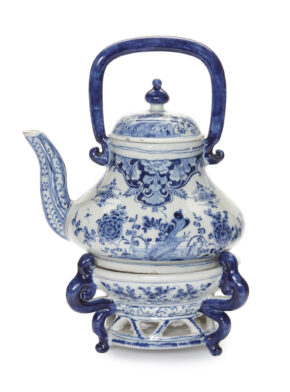
[popup_trigger id=”13756″ tag=”span”]![]() [/popup_trigger]
[/popup_trigger]
Images on this website are licensed under a
Creative Commons Attribution-NoDerivs 3.0 Unported License.
OBJECT
D1607. Pair of Blue and White Fan-Shaped Sweetmeat Dishes
Delft, circa 1690
Each marked / D PAUW 2 in blue for De Paauw (The Peacock) factory
Each painted with a crane standing beside a pierced rock beneath a tall floweringpeony plant and leafy stems, the narrow rim with a pointed top and a bracket-shaped lower edge, each bordered with a stylized flowering leafy vine.
Lengths
18.3 and 18.5 cm. (7.2 and 7.3 in.)
Note
Dishes of this shape, when assembled as a set of eight surrounding a central star-shaped dish, traditionally were thought to have been made as ‘rijsttafel’ sets. However, the current thinking is that because they have been found to be referred to in inventories as ‘confituur-starren’ (’preserve sets’), most probably they were used to serve sweetmeats and other delicacies such as dried fruit or summer fruit preserved in brandy. By the seventeenth century, the cultivation of sugarcane in Brazil and the Caribbean made the importation of large quantities of sugar possible, and honey, initially used as the most prevalent sweetener, was replaced by refined cane sugar. The availability of sugar as its sources increased and its price declined throughout the seventeenth and eighteenth centuries, caused the general popularity of sugared orange peels, sugar-coated nuts and seeds, sometimes even colored, pear marmalade and preserved ginger, chestnuts and fennel. All of these delights were presented in small dishes such as these, but based on the consistently early dates of surviving sets and their component dishes, made by a number of the major factories, they would appear to have enjoyed an important but somewhat short-lived vogue in Dutch Delftware. A full set of a more elaborate shape is illustrated in Aronson 2012, pp. 24-24; and in Stodel 2000, p. 57, no. 42, with the suggestion that such sets “may have been modeled on the small dishes of fanciful and ingenious shapes, which were employed in Japan for the tea ceremony and which reached Europe around 1670.”








